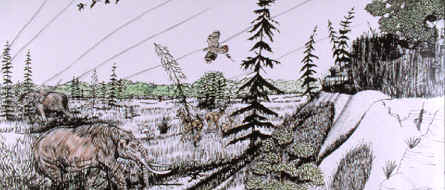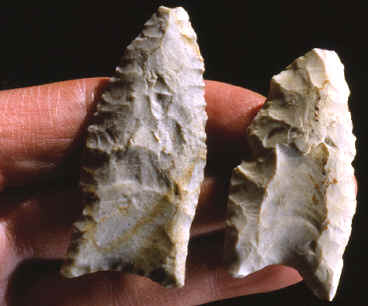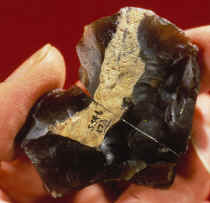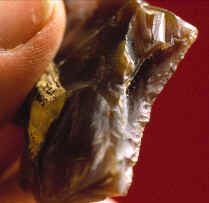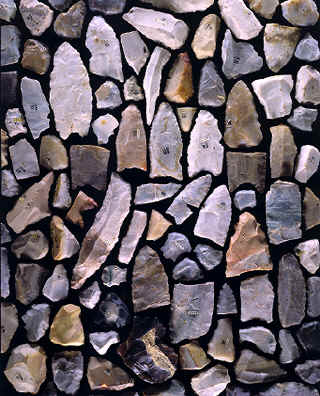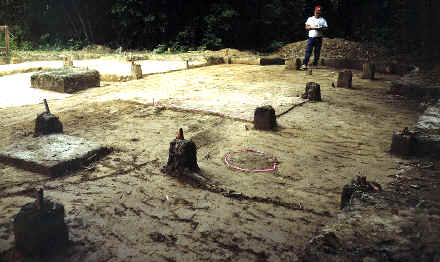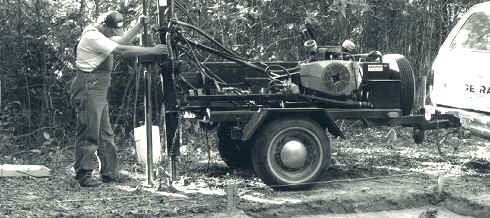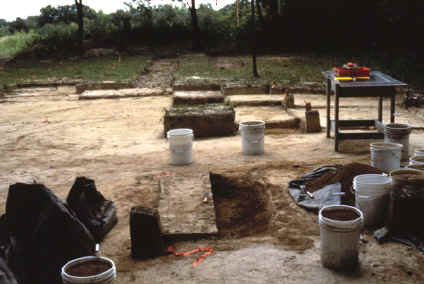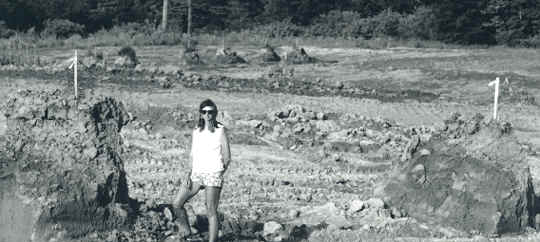|
THE
BOSTROM SITE ST. CLAIR COUNTY, ILLINOIS 12,000 to 13,000 YEARS BEFORE PRESENT 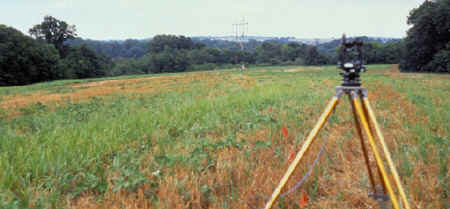 THE BOSTROM CLOVIS SITE ST. CLAIR COUNTY, ILLINOIS Most Clovis sites discovered to date were "open air" camp sites. These sites continue to give us the greatest insight into these early peoples nomadic way of life. This picture shows a view from the highest level of the Bostrom site. Many Clovis camp sites like this one are located on high hills over looking major flood plains. These locations were useful for observing large game. The main archaeological excavation of the Bostrom site was located at the far right end of the field and extending into the tree line just out of view of this picture. For several years, Clovis artifacts were surface collected in a wide area within this cultivated field.
This could be a scene from the Bostrom site twelve or thirteen thousand years ago in St. Clair County, Illinois. Two Clovis hunters can be seen on the high ground at the upper right observing various animals and two large mastodons on the flood plain below. These early people were living during a time when very large animals called the megafana were still alive. Some of these animals included the mammoths, mastodons, short-faced bear, ground sloths, musk oxen, giant wolf, horses, camels and several different kinds of bison. The Bostrom Clovis site is located about sixteen miles east of St. Louis, Missouri in St. Clair County, Illinois. My brother Rob Bostrom first discovered the site in the 1970's when he was riding his trail bike along a newly bulldozed path for high voltage electric lines. He stopped for a few moments on a newly plowed hill that was situated above the Silver Creek flood plain. During this break from riding he walked in the field and picked up three broken Clovis points. They were all either broken during manufacture or by some other way in ancient times. In all the following years of surface collecting no one ever found that many Clovis points in any one day again.
ST. CLAIR COUNTY, ILLINOIS Both of these fluted points were found in the plowed field on the Bostrom site by Pete Bostrom. The smaller point was probably resharpened until it was discarded as no longer useful. This point is made of Burlington chert and the larger point is made of Mill Creek chert. The longer point measures 2 5/8 inches long. The location of the site was immediately brought to the attention of local archaeologists, but although they thought it was an important site no one had any time for a thorough investigation. At that time the field had only been plowed two or three times and the site extended on the other side of a fence where it had never been disturbed. Over the years as the field was heavily plowed there was quite a lot of erosion. Ditches three and four feet deep were washing out in some areas.
One of
the most interesting raw materials found on the Bostrom site is this
scraper made from Knife River chert which was found by myself in two
pieces about one year apart. The quarry site for Knife River chert is
located in North Dakota. Small pieces of this material have been found in
the Missouri and Mississippi Rivers. Because this piece was struck off a
larger core it's possible that Clovis hunters carried it down from North
Dakota. For the Clovis culture the distance from North Dakota to the
Bostrom site of 940 miles would be one of
the farthest distances recorded for transporting a stone tool or the raw material to
make it. Evidence for even farther distances have been reported on much
later sites. Obsidian from Yellowstone has been found on Woodland sites in
eastern Ohio. What was so remarkable about the Bostrom site was the amount of diverse types of cherts brought in from so many different directions. More that 57% is non-local. One large scraper was made from Knife River chert. This material is found only in North Dakota over 900 miles away (except for small pieces that have been found in the Missouri and the Mississippi Rivers). All the other materials originate within about a 190-mile radius. Quite a lot of Indiana Green chert (Attica) was brought in from quarry sites located far to the east and Cobdin, Kaolin and Mill Creek cherts were brought in from sites located far to the south. Early Paleo-Indian people were very mobile and the multitude of different cherts found on this site helps to prove they were living a nomadic lifestyle.
This picture shows some of the many artifacts that were surface collected on this site over a period of approximately 15 years. All of the complete and broken Clovis projectile points are shown along with several end-scrapers, side-scrapers, gravers and perforators. Notice the wide range of materials used to make these tools. The farthest traveled material is the large scraper made of Knife River chert from South Dakota located at the bottom center of this picture. Also notice that some of the tools are made on core blades which is a trademark of Clovis tool making technology. The Bostrom site was a campsite that is located in an area where there is no natural source of workable stone for tool making. Itís also located high on a hilltop that would have been a good lookout for observing large animals in the valley below. These people probably camped here periodically as they followed certain animals on a seasonal schedule and gathered other sources of food.
This picture shows several of the squares that had been taken down to sterile soil in the main excavation area. One or two fire pits and one oval feature was found.
The equipment in this picture is used for taking core samples of the soil. This picture was taken on October 28, 1991 and it shows Dr. Ken Tankersley taking a core sample near the excavated area on the Bostrom site. The surface collected artifacts from the Bostrom site were studied by many different archaeologists over the years. Eventually, in 1990 after it was realized that the site would be completely destroyed by land leveling and subdivision, Dr. Ken Tankersley from the Illinois State Museum organized a group of professional and amateur archaeologists to investigate the site. Several test excavations in the plowed field and precise recording of surface collected artifacts was done. But the investigation mainly focused on a small area of undisturbed ground where a Paleo-Indian horizon was identified. A spurred end-scraper was found in unit 94 and other Paleo artifacts were found during excavation including three fluted biface fragments, a channel flake and four side scrapers.
This picture shows the main excavation at the Bostrom site where some of the original living surface has been exposed. The excavated surface here would be approximately 13,000 years old. The partly excavated oval feature in the lower center contained bone apatite and may have been a burial but since bone apatite is a part of all bones this possibility was inconclusive. There was also one broken fluted point found in this feature made of Burlington chert from Illinois or Missouri. Itís too bad the site was so completely destroyed. About four and five feet of the surface of the field was stripped to fill in a gully for a road. In the area where the undisturbed site was located, many more feet were removed. You now have to point to the sky to indicate where where the site once was.
The arrow in this picture is pointing to a small channel or flute flake still in place where it was discovered. This flake was struck off during the manufacture of a Clovis point. It's made of Attica chert that was originally collected on quarry sites in Indiana and brought to western Illinois If it wasn't for the countless miles of surface collecting for well over ten years by myself and my brother this site would have been destroyed without anyone ever having known it was there. Surface collecting by the non professional public is important. The majority of all Paleo-Indian sites in North America were discovered by people who were surface collecting.
ST. CLAIR COUNTY, ILLINOIS This picture was taken in what was once the cultivated field where most of the known area of the Clovis site was located. Unfortunately, as can be seen by the surveyors stakes atop five to six foot columns of dirt, the original site no longer exists. |
